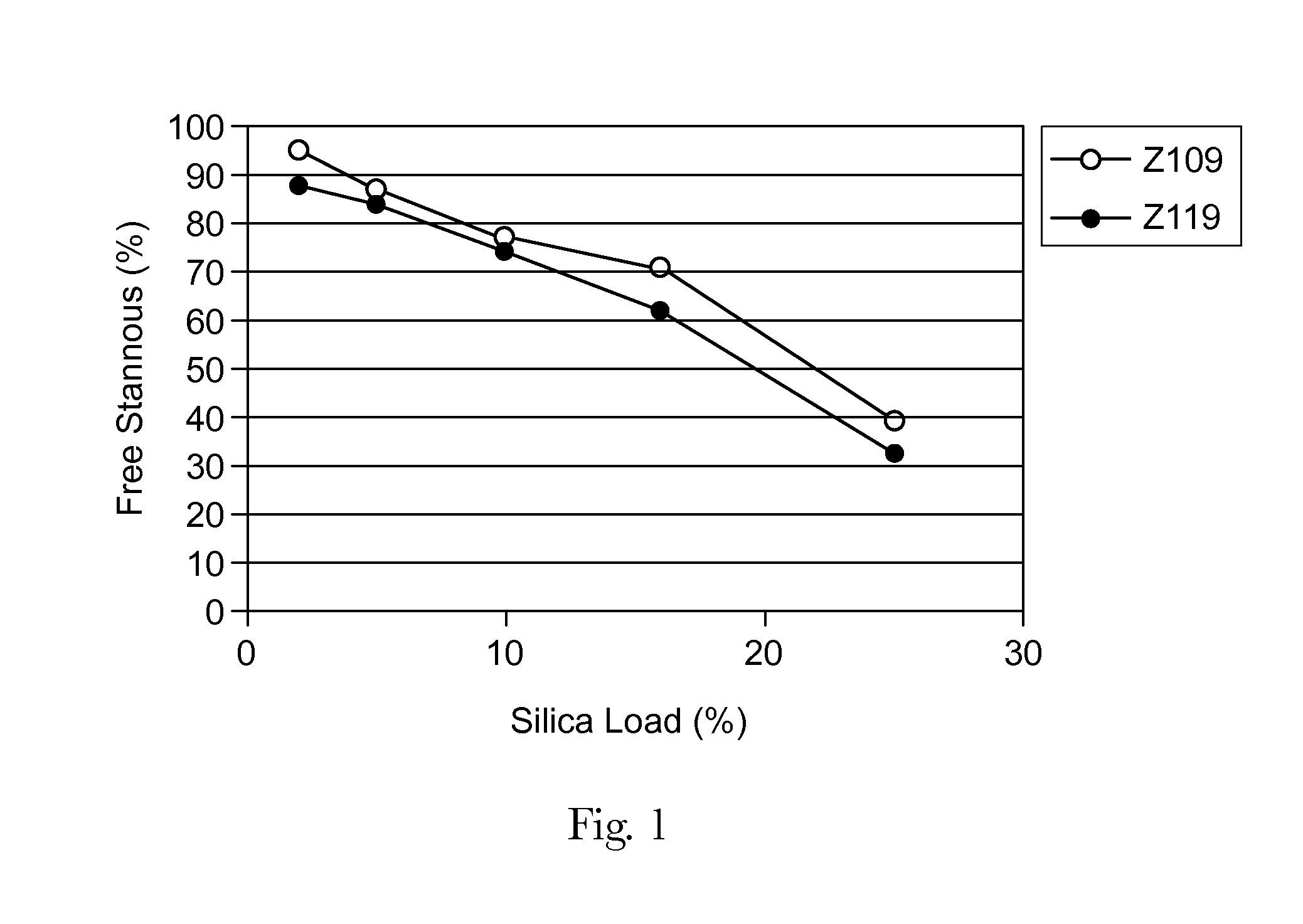Stannous Chloride Compositions
- Summary
- Abstract
- Description
- Claims
- Application Information
AI Technical Summary
Benefits of technology
Problems solved by technology
Method used
Image
Examples
example 1
[0033]The following example illustrates the loss in soluble stannous availability in the presence of silica. A solution based experiment demonstrates the interaction and percent free stannous availability when mixed with different concentrations of two different types of silica; Zeodent® 109 and Zeodent® 119. Solutions containing 36% by weight glycerine (liquid) and 0.6% by weight sodium gluconate (solid) (to prevent oxidation and hydrolysis of stannous ions) were made and individually added to various amounts of silica (from ranges of zero to 25% by weight). Thus the amount of silica was the single experimental variable (see table below). The total weight was adjusted with water and then finally sodium fluoride and stannous chloride (0.243 and 0.654% by weight respectively) were added. The mixtures were allowed to mix for 24 hours and then analyzed for soluble stannous (free unbound stannous) via inductively coupled plasma after centrifugation and a 1:3 dilution with water.
TABLE 1%...
example 2
[0035]In order to determine the stannous ion stability in the solid particulate composition of the present invention, a Raw Material Stability assay was carried out which compared stannous chloride dihydrate alone with stannous chloride dihydrate mixed with 3% silica Zeodent® 119. Soluble stannous levels were measured using atomic absorption. At 25° C. and 60% relative humidity and at 40° C. and 75% relative humidity there was no significant difference between the stannous stability in the stannous-silica blend as compared with the stannous without the silica over a four week period. This compares with a drop to 85% of free stannous ions in the presence of 3% silica at 25° C. in the solution assay described in Example 1. The comparative stability of the solid particulate composition of the present invention was therefore unexpected.
TABLE 2Raw Material Stabilityassay25° C.40° C.(4 week storage)60% Relative Humidity75% Relative HumiditySnCl2 2H2O98.494.7SnCl2 2H2O-silica blend98.897.2...
example 3
[0036]To ensure the optimal material blend and to minimise the formation of lumps, the mixing of the silica with the stannous chloride should be conducted at the commencement of the manufacturing process of the raw material. This will ensure uniform blending. Specifically, following the process in which the stannous chloride (dihydrate or anhydrous) is formed, 1% hydrated silica, Z119 with a particle size of 6-15 μm, is blended via tumble mixing to form a uniform mix that is then supplied for incorporation into toothpaste production. For use in the manufacture of toothpaste, the blended material is either transferred into storage bins and discharged or used directly, as per the required dosage.
[0037]Stannous chloride both with and without silica admixed were exposed to controlled environmental conditions of 30° C. & 60% relative humidity for the period of the study and assessed both for material activity & flowability.
TABLE 3Stannous Chloride dihydrateStannous Chloride dihydrate &(R...
PUM
 Login to View More
Login to View More Abstract
Description
Claims
Application Information
 Login to View More
Login to View More - R&D
- Intellectual Property
- Life Sciences
- Materials
- Tech Scout
- Unparalleled Data Quality
- Higher Quality Content
- 60% Fewer Hallucinations
Browse by: Latest US Patents, China's latest patents, Technical Efficacy Thesaurus, Application Domain, Technology Topic, Popular Technical Reports.
© 2025 PatSnap. All rights reserved.Legal|Privacy policy|Modern Slavery Act Transparency Statement|Sitemap|About US| Contact US: help@patsnap.com

